During September the Group held its Annual General Meeting which was followed by talks by Kevin Moran and Alison Foster. These are reported on below. The Group also joined the Professional Horticultural Group South West to visit Golden Acres Nurseries and Knoll gardens in Dorset, again reported below.
October sees the cider apple harvest in full swing and on 25 October 2011 we will be visiting three contrasting cider makers from large to small scale as well as looking at perry production from pears.
Editor
Bedding plants, rippling sand and ornamental grass
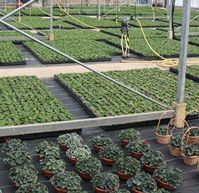
The tour started in the West Parley Garden Centre which unashamedly concentrates on selling quality plants and does not sell the garden furniture and 'household decor' etc. that many others do. They find this a successful formula despite having more typical garden centre competitors in the immediate area. Apart from plants and plant accessories the other main source of income is an atmospheric restaurant built in an old cavalry stables.
The production nursery is in three sections. The first is a cash and carry sales area, selling a range of shrubs and herbaceous plants to landscapers. These plants together with those for the garden centres are all bought in and, where possible, sourced from UK producers. With the current exchange rates, buying from European countries is expensive and so more than ever is UK sourced.
The main area of the nursery is used for bedding plant production. They aim to operate on a relatively simple low cost system and as a result concentrate on a few uncomplicated lines. 'Too much choice confuses the customer' reckons Simon. The latest victim of 'complications' is the traditional Busy Lizzie. While easy to propagate, the customer will inevitably lose them to downy mildew and be disappointed and the nursery does not want disappointed customers.
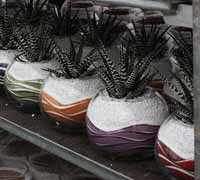
The final section of the nursery specialises in a few added-value products. These include hanging baskets but their main line is a decor item 'sand art' using coloured sand and low maintenance plants (picture right). Trained operators (all Polish women) fill ornamental glass containers with coloured sands to create a ripple effect. The sand is filled around a pot so that a plant can be dropped in to complete the product. The plant of choice seemed to be Haworthia attenuate f clariperla, a small architectural succulent.
The group moved on to Knoll Gardens where proprietor Neil Lucas showed us round his demonstration garden. Neil has collected grasses and sedges from all round the world then selected, and now propagates and sells, those he feels have horticultural value in the UK. His collection of 6-700 lines ranges from low growing grasses and sedges through the taller Stipa and Miscanthus to bamboos. However he does not sell the latter as he regards them as too vigorous for the average garden. His garden, created from a carrot field, now benefits from a framework of mature trees providing both shelter and a mix of sun and shade to provide suitable habitats for the full range of species he grows.
Although the main emphasis of the nursery is the use of ornamental grasses Neil is happy to grow large numbers of standard Festuca for planting green roofs.
AGM, Fertilisers and Prairie planting
The main formalities of the 2011 Annual General Meeting of the Horticulture Group took place without incident. Thanks were recorded to those members of the Committee who were retiring, Nigel Kirby, Phil Mullington and Marion Stainton. In their place four new members were elected; Susan Cole, Chris Moncrieff, Kevin Moran and Julian Perfect.
Yara - Fertilisers for Horticulture

Yara International now has annual global revenues of around £6.5 billion and a workforce of more than 7,300 in 150 countries. Yara is very active in R&D with many research programmes worldwide which tackle the problems encountered by farmers and growers of a diverse range of crops. Dr Moran's particular interest is in mineral e.g. calcium and micronutrient e.g. zinc nutrition of crops and in improving food quality through bio-fortification.
In bioresources terms, Yara is looking at the key global challenges in the areas of food, energy, climate and health. He acknowledged that use of fertilisers gets a bad book from some writers particularly in the developed world. But many of these do not appreciate the value of adding both macro- and micronutrients to food crops. Sadly in some countries, growers still believe that the more fertiliser you add, the higher the yield, ad infinitum, while in others, crops are grown without fertilisers until the soil is exhausted and no longer productive. Soil analysis is vital to ensure the right fertiliser, is added at the right time, in the right place and in the right amount which maximises crop production, while minimising run-off and reducing carbon footprint.
The two most critically-needed micronutrients in the developing world are Vitamin A and zinc. Kevin showed the correlation between yield and nutritional value of rice and wheat crops if nitrogen and zinc fertilisers are added together. This means that infants in the developing world can enjoy an improved supply of the micronutrient when currently 400,000 children die each year through lack of zinc in their food.
Sowing the Seeds of Change – The New Merton Border at Oxford Botanic Gardens
Dr Alison Foster then described the plans for a new border in the 'lower' area of Oxford Botanic Gardens (OBG), based on the research on sustainable herbaceous planting of Prof James Hitchmough of Sheffield University.
The original aim of redeveloping the area was to provide an aesthetically pleasing border. But since OBG is a dedicated provider of education and the 'lower' garden already has displays of fruit- and vegetable-growing, and an herbaceous border, with a wide mix of well-known and more specialist species. The area to be developed, starting in 2011, measures 955m2; the largest single cultivable area within OBG. The aims are to promote sustainable development, with minimal detriment to the environment; celebrate plant diversity; and provide an ornamentally inspiring feature.
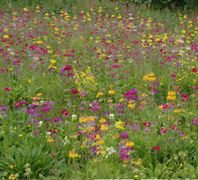
James Hitchmough's research has shown the balance and mix of seed species which work together to provide a display, over an extended season, of flowers and ground-cover for a number of years, with minimal maintenance. The 'Merton' Bed at OBG will be treated with glyphosate, and the pernicious Nothoscordum fragrans (a garlic relative, with highly efficient powers of spreading, through prolific bulblets), is being removed by hand-digging and electrocution. The top 8cm of soil will be removed and replaced with an equivalent layer of weed free sand. Alison emphasised that this regime is not the equivalent of preparing land for a wildflower meadow; the aim is not to depress soil fertility.
The Hitchmough seed mix will be sown at the end of October, to allow for vernalisation. The bed will be covered with jute matting, similar to that at Burgess Park. The bed will be irrigated next Spring, to help seedlings establish.
Maintenance will consist of cutting back the plant haulms in late winter., and burning them off every few years, as necessary. The plant 'sward' should be sufficiently dense to prevent weed problems.
Margaret Waddy
Group Honorary Secretary
Plant of the Month
Cucumber, Cucumis sativus, Cucurbitaceae
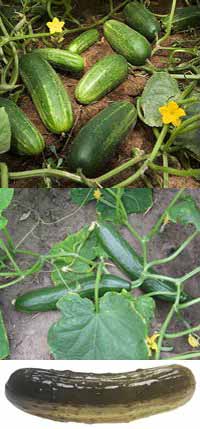
The cucumber is naturally monoecious with separate male and female flowers on every plant. The main stem remains persistently 'male' for some considerable length but the first two leaf nodes on every sideshoot normally bear female fruit and this is where the crop is borne. However, it means the sideshoots need constant trimming to encourage more sideshoots and more female flowers. Many modern parthenocarpic varieties carry a gene that makes them all-female so that every leaf node on the main stem and sideshoots bears only female flowers. This reduced the need for trimming and also helps to avoid the bitter taste that can come from pollination of these varieties.

A third type of cucumber cultivar is the gherkin. These are smaller fruited varieties of ridge cucumbers that have been selected for pickling. They tend to have smaller fruit and denser flesh than slicing cucumbers. They are harvested immature in the same way as slicing cucumbers and pickled in either vinegar or brine.
News from our Associates

The ISHS holds a great many meeting each year throughout the world. Most of
these are notified in our eEvents Calendar below. The talks given at these
meetings are routinely reported in Acta Hoticulturae, a full list of which
can be found here.

In conjunction with the Institute of Physics and Royal Society of Chemistry
the Society has submitted a joint response to the White Paper on Higher Education.
The Society is also launching in November a new special interest group, the UK Plant Science Federation, to bring together stakeholders from across the plant science community. The Horticulture Group has agreed to join this group on behalf of SCI and Professor Geoff Dixon has agreed to be our representative. More
Horticulture Industry News
For the very latest horticultural news follow us on Facebook and or
Twitter.
Plants take in more CO2 than thought
Scientists might be able to predict climate change with more accuracy after
discovering that plants consume carbon dioxide 25 percent faster than previously
thought. The finding could help refine efforts to fight global warming just
at a time when U.N. talks are struggling to agree on a broader climate pact
that will be the focus of a major meeting in December in South Africa. Better
and more accurate climate science can help change energy policies.
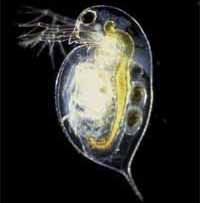
Unprecedented
algae growth in some lakes could be linked to the decline of water calcium
levels and the subsequent loss of an important algae-grazing organism that
helps keep blooms at bay. Daphnia - also known as water fleas - acts like microscopic lawnmowers
in lakes, feeding on algae and keeping it in check. However, without sufficient
calcium, these water fleas cannot reproduce. Declining calcium concentrations
in some lakes, which is linked to acid deposition and logging, has only recently
been identified as a serious environmental problem in North America and Europe. More
Dipping tongues allow bees to drink the sweetest nectar
US mathematicians have worked out why the flowers pollinated by bees have
sweeter nectar than those visited by butterflies. When it comes to drinking
nectar, the most important factor is whether the insects dip their tongue
in, or whether they suck the liquid up. The sweeter the nectar, the thicker
it is, and research found that the dipping method of bees is ideal for drawing
up the most viscous liquid. By making mathematical models that take into account
how the thickness, or viscosity, of nectar changes with increasing sugar concentration,
the researchers were able to find out what feeding method was best for drinking
nectar with varying sweetness, testing the idea that plants and their pollinating
insects have co-evolved. More
Spicing up Broccoli boosts cancer-fighting power
Eating fresh broccoli with a spicy food that contains the enzyme myrosinase
significantly enhances each food's individual cancer-fighting power and ensures
that absorption takes place in the upper part of the digestive system where
you get the maximum health benefit. To get this effect, spice up your broccoli
with broccoli sprouts, mustard, horseradish, or wasabi. The spicier, the better.
When fresh broccoli sprouts were eaten with broccoli powder, scientists were
able to measure bioactive compounds in the blood 30 minutes later. When these
peaked at three hours, they were much higher when the foods were eaten together
than when either was eaten alone. More
Groundwater greed drives sea level rises
Slowly and almost imperceptibly the seas are rising, swollen by melting ice
and the expansion of seawater as it warms. But there's another source of water
adding to the rise: humanity's habit of pumping water from underground aquifers
to the surface. Most of this water ends up in the sea. Not many scientists
even consider the effects of groundwater on sea level, says Leonard Konikow
of the United States Geological Survey. Konikow measured how much water had
ended up in the oceans by looking at changes in groundwater levels in 46 well-studied
aquifers, which he then extrapolated to the rest of the world. He estimates
that about 4500 cubic kilometres of water was extracted from aquifers between
1900 and 2008. That amounts to 1.26 centimetres of the overall rise in sea
levels of 17 cm in the same period. More
Lessons to be learned from nature in photosynthesis ....
If we can learn from nature and develop an artificial version of photosynthesis
we would have an energy source that is absolutely clean and virtually inexhaustible.
'Solar energy is forecasted to provide a significant fraction of the
world's energy needs over the next century, as sunlight is the most abundant
source of energy we have at our disposal,' says Graham Fleming at the
University of California, 'However, to utilise solar energy harvested
from sunlight efficiently we must understand and improve both the effective
capture of photons and the transfer of electronic excitation energy.' More
....Moss shows the way to do it
A team of designers and scientists at Cambridge University will be exhibiting
a novel moss table at the London Design Festival later this week. The prototype
table will showcase an emerging technology called biophotovoltaics (BPV) which
uses the natural process of photosynthesis to generate electrical energy.
Featuring biological fuel cells made from moss, the table has been created
as a vision of the future. Still at early stages, BPV has the potential to
power small devices such as digital clocks. Low cost BPV devices may become
competitive alternatives to conventional renewable technologies such as bio-fuels
in the next ten years.
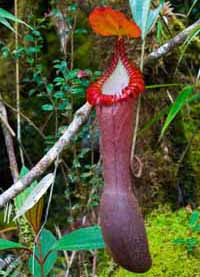
Water,
oil, blood and insects alike slide swiftly off a new super-slippery material
inspired by a carnivorous plant. Scientists searching for clever materials
sometimes borrow ideas from nature. The leaves of Lotus (Nelumbo nucifera),
for example, are famously water repellant, thanks to their textured surfaces
which trap a cushion of air for water to slide down. The leaves have inspired
a range of so-called 'superhydrophobic' materials. But these materials
have trouble repelling oils and more complex liquids, which have lower surface
tensions than water and can seep into the surface at the slightest pressure.
Now, a new material takes a cue from one of the plant world's few meat-eaters:
the carnivorous pitcher plant Nepenthes. The plants prey on insects, whose oily feet normally allow
them to walk up walls. But pitchers' tube-shaped leaves have microscopic bumps
that hold a thin layer of water in place. The water repels the oils, sending
hapless insects slipping straight into their gaping mouths. More
Bulk chemicals from plant materials
Researchers from four companies are working together with researchers at Wageningen
to develop processes that will, for the first time, produce the bulk chemicals
styrene and acrylic acid from plant materials. Styrene and acrylates are two
of the most widely used types of bulk chemicals in the world, and they are
presently being produced from fossil sources. These chemical building blocks
are, in turn, used to produce coatings, optical fibres, plexiglass, glues,
plastics etc. In the research project these bulk chemicals are produced using
plant-based sugars and protein-rich residual biomass released during the production
of biofuels.
You are what you eat!
MicroRNAs from common plant crops such as rice and cabbage can be found in
the blood and tissues of humans and other plant-eating mammals. One microRNA
in particular, MIR168a, which is highly enriched in rice, was found to inhibit
a protein that helps removes low-density lipoprotein (LDL) from the blood,
suggesting that microRNAs can influence gene expression across kingdoms.
'This is a very exciting piece of work that suggests that the food we eat may directly regulate gene expression in our bodies,' said Clay Marsh at the Ohio State University. MicroRNAs are, as the name implies, very short RNA sequences (approximately 22 nucleotides in length) discovered in the early 1990s. They are known to modulate gene expression by binding to mRNA, often resulting in inhibition. With the recent discovery that microRNAs circulate the blood by hitching a ride in small membrane-encased particles known as microvesicles.
Weed identification by mobile phone
An innovative new mobile phone app that will help growers identify weeds on
their farms will be launched by BASF at the beginning of next month. The app
contains 140 arable grass and broad-leaved weeds and over 1,000 photos to
aid identification. Users can take a picture of the weed they are trying to
identify, which remains as a smaller image on screen while users filter weeds
out by choosing characteristics relating to the weed, such as cotyledon and
leaf shape. More
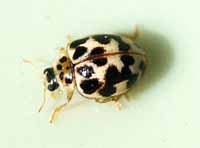
Mycophagous
ladybird beetles (Coleoptera: Coccinellidae) feed on powdery mildew and have
considerable potential as biological control agents; however, the foraging
ecology and behavior of these beetles is not well understood. Now the olfactory
cues presented by squash plants (Cucurbita moschata) infected by
powdery mildew (Podosphaera sp.) have been studied as well as the
behavioral responses of twenty-spotted ladybird beetles to these cues. Volatile analyses through gas chromatography
revealed a number of volatile compounds characteristic of infected plants,
including 3-octanol and its analogues 1-octen-3-ol and 3-octanone.
These compounds are typical “moldy” odorants previously reported in volatiles collected from other fungi. In addition, infected plants exhibited elevated emissions of several compounds also observed in collections from healthy leaves, including linalool and benzyl alcohol, which are reported to have anti-fungal properties. In Y-tube choice assays, P. vigintimaculata beetles displayed a significant preference for the odors of infected plants compared to those of healthy plants. Moreover, beetles exhibited strong attraction to one individual compound, 1-octen-3-ol, which was the most abundant of the characteristic fungal compounds identified. More
Autumn crocus fights cancer
Researchers are poised to start clinical trials with a new 'smart bomb'
treatment, derived from the autumn crocus (Colchicum autumnale),
targeted specifically at tumours. The treatment is able to slow the growth
of and even completely 'kill' a range of different cancers, in experiments
with mice.
The native British autumn crocus, otherwise known as 'meadow saffron' or 'naked lady', contains the potent chemical colchicine, which is known to have medicinal properties, including anti-cancer effects. But colchicine is toxic to other tissues in the body, as well as cancer, so until now its use has been limited. The researchers have now altered the colchicine molecule so it is inactive in the body until it reaches the tumour. Once there, the chemical becomes active and breaks up the blood vessels supplying the tumour, effectively starving it. More
Potential control for Erwinia rots
The bacterial diseases blackleg and wet rot represent a major challenge to
growers of seed potatoes and flower bulbs. There are no ways to control these
pathogens nor are there any resistant varieties. A scientist in the Netherlands
has discovered how the organism that causes blackleg and wet rot, the Dickeya
bacterium (Erwinia), spreads in the potato plant. He also discovered
an antagonistic bacterium that can be used to control the Dickeya bacteria.
More knowledge about the ecology of the pathogenic bacteria could contribute
to a better way of controlling these diseases.
Using less water to grow more potatoes
Most commercial potato producers use ridged-row planting systems but this
planting configuration allows irrigation runoff to collect in the furrow and
percolate below the crop root zone. This water is unavailable to the crops,
and can also lead to increased nitrate leaching from the soil. American researchers
have found that using the flat beds increases yields by an average of 6 percent,
even though 5 percent less water was used for irrigation. This means that
using flat beds instead of ridged rows for potato production could lead to
an overall 12 percent increase in irrigation water use efficiency. More
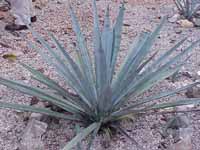
Agave
tequilana, the plant used to make tequila and fibres for rope,
has proved a handy alternative feedstock to corn or sugarcane in the production
of bioethanol fuel. The sustainability of large-scale biofuel production has
recently been called into question because of mounting concerns over the impact
on land and water resources. Now a team at the University of Oxford has studied
the viability of using Agave as an alternative feedstock because
it can be grown in an arid environment.
In the US, bioethanol is produced from corn, which is very water and fertiliser intensive and requires a significant amount of land. The result is a trade-off between feedstocks for the food markets and feedstocks for bioethanol production. In Brazil, bioethanol is produced using sugarcane. But again, land that could be used to grow food is needed to grow this and the question is: which is more important, food or fuel? More
Quotes of the Month
'Slash-and-Burn' is when research councils keep changing priorities, causing scientist to change areas to maintain funding!!
Sophien Kamoun, The Sainsbury Lab
Events Calendar
Technicalvisit to Warburtons
2 Oct, Institute of Food Science and Technology
Enfield, UK
Genetic
Diversity in Carrot, Open Afternoon
3 Oct, Warwick Crop Centre
Wellesbourne, UK
Meet
the staff
3 Oct, Oxford Botanic Garden
Oxford, UK
South West Growers Show
5 Oct, South West Growers
Exeter, UK
Balkan Symposium on
Vegetables and Potatoes
9 - 12 Oct, International Society for Horticultural Science
Tirana, Albania
ProMusa
International Symposium
10 - 14 Oct, International Society for Horticultural Science
Salvador, Brazil
The
Application of Nanotechnology in the Food and Food Packaging Industries
11 Oct, Institute of Food Science and Technology, Institution of Mechanical
Engineers
London, UK
New
technologies for early pest and disease detection
12 Oct, Association of Applied Biologists
Marston, UK
High
Tunnel Horticultural Crop Production
16 - 19 Oct, International Society for Horticultural Science
Pennsylvania, USA
Acclimatisation
and Establishment of Micropropagated Plants
16 - 20 Oct, International Society for Horticultural Science
Nebraska City, USA
The
gene garden
17 Oct, Oxford Botanic Garden
Oxford, UK
Growing
Media, Composting and Substrate Analysis
17 - 21 Oct, International Society for Horticultural Science
Barcelona, Spain
Biofumigation
and Biopesticides Symposium
18 - 20 Oct, Ag-West Bio
Saskatoon, Canada
National
Fruit Show
19 - 20 Oct, The Marden Fruit Show Society
Detling, UK
Manipulating plant genes - how do you actually do it?
24 Oct, Oxford Botanic Garden
Oxford, UK
Colour
in the garden
27 Oct, Oxford Botanic Garden
Oxford, UK
From hairy roots to new medicines
31 Oct, Oxford Botanic Garden
Oxford, UK
CropWorld
Global
31 Oct - 2 Nov, British Crop Protection Council
London, UK
Hortifair
1 - 4 Nov, Amsterdam RAI
Amsterdam, The Netherlands
Scotsturf
2 - 3 Nov, Institute of Groundsmanship
Edinburgh, UK
Postharvest and
Quality Management of Horticultural Products of Interest for Tropical Regions
2 - 4 Nov, International Society for Horticultural Science
Bogota, Colombia
Pyrethrum,
The Natural Insecticide
2 - 4 Nov, International Society for Horticultural Science
Hobart, Australia
Plants in a chemical world
7 Nov, Oxford Botanic Garden
Oxford, UK
Southern
Growers Exhibition
9 Nov, Southern Growers
Chichester, UK
International
Symposium on Date Palm
13 - 14 Nov, International Society for Horticultural Science
Algiers, Algeria
GM crops - where do we go from here?
14 Nov, Oxford Botanic Garden
Oxford, UK
International
Symposium on Tropical Wines
14 - 16 Nov, International Society for Horticultural Science
Chiang Mai, Thailand
Medicinal
and Aromatic Plants
15 - 18 Nov, International Society for Horticultural Science
Chiang Mai, Thailand
World Fruit and Vegetable
Expo
16 - 17 Nov, WVF Expo
London, UK
Management
of Tuta absoluta
16 - 18 Nov, EPPO/IOBC/FAO/NEPPO
Agadir, Morocco
Onion
and Carrot Conference
16 Nov - 17 Nov, Processed Vegetables Growers' Association
Peterborough, UK
Epigenetics
and Tomato Improvement
17 Nov, Society of Biology
Sutton Bonnington, UK
Medicinal and Aromatic
Plants
20 - 23 Nov, International Society for Horticultural Science
Antigua, Guatemala
Achieving food security and sustainability for 9 billion
21 Nov, Oxford Botanic Garden
Oxford, UK
Symposium
on New Floricultural Crops
22 - 25 Nov, International Society for Horticultural Science
Buenos Aires, Argentina
IAgrM BIAC National Conference
23 Nov, British Institute of Agricultural Consultants
Details to Follow
Trees
– A cut above the rest
24 Nov, Oxford Botanic Garden
Oxford, UK
Symposium
on Papaya
24 Nov - 27 Nov, International Society for Horticultural Science
Chiang Mai, Thailand
Frontiers
of Citrus
27 - 30 Nov, International Society for Horticultural Science
Tel Aviv, Israel
Solanaceae and Cucurbitaceae
Joint Conference
28 Nov - 2 Dec
Kobe, Japan
Biopesticide
International Conference
28 - 30 Nov, Journal of Biopesticides
Palayamkottai, India
Biopesticides
29 Nov, Association of Applied Biologists
Marston, UK
Symposium
on Tropical and Subtropical Fruits
29 Nov - 2 Dec, International Society for Horticultural Science
Chiang Mai, Thailand
Advances
in Biological Control
30 Nov, Association of Applied Biologists
Marston, UK
National
Landscape Awards
2 Dec, British Association of Landscape Industries
London, UK
Quality Management
in Supply Chains of Ornamentals
3 - 6 Dec, International Society for Horticultural Science
Bangkok, Thailand
Postharvest Quality
Management of Root and Tuber Crops
3 - 6 Dec, International Society for Horticultural Science
Bangkok, Thailand
Postharvest
Pest and Disease Management in Exporting Horticultural Crops
3 - 6 Dec, International Society for Horticultural Science
Bangkok, Thailand
Quality Management
in Postharvest Systems
3 - 6 Dec, International Society for Horticultural Science
Bangkok, Thailand
Cashew Nut
9 - 12 Dec, International Society for Horticultural Science
Madurai, India
Vegetable
Nutrition and Fertilisation: Vegetable Farms Management Strategies for Eco-Sustainable
Development
19 - 22 Dec, International Society for Horticultural Science
Giza, Egypt
If you would like to advertise a forthcoming event please contact. zoe.daniel@soci.org
Horticulture Group Contact Details
For submitting ideas or to volunteer to be part of a committee or a group, please contact:
Chairman - Peter Grimbly
Meetings Secretary - Marion Stainton
Minutes Secretary - Margaret Waddy
Newsletter Co-ordinator - Sue Grimbly, E: scihortigroup@btinternet.com
Group Coordinator - Zoe Daniel zoe.daniel@soci.org T: +44 (0)20 7598 1594
